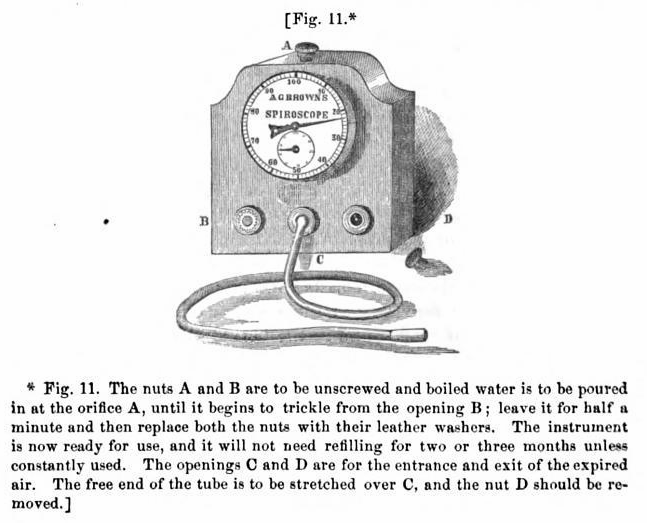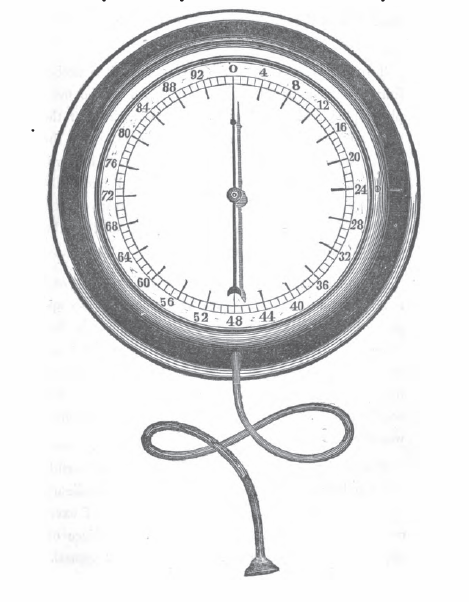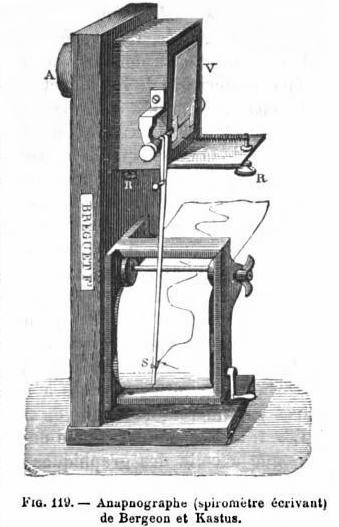From: The Science and practice of medicine, Volume 2, by William Aitken, 1866, page 553. “Mr. A. Gardiner Brown’s spiroscope is a new and efficient instrument for ascertaining the breathing capacity. It is a wet meter, 6-1/2 inches square, having a dial with two registers, revolving from left to right, marking in a complete revolution 100 and 1000 cubic inches respectively, and a few feet of vulcanized India-rubber tubing to breathe through. Its advantages are facility of management, compactness, portability, security of contained fluid and it may be used several times by the same person without readjustment. The air is measured at its initial temperature. The patient should be taught to practice a powerful inhalation, and as complete an expiration as possible, before noting the mean numbers registered in several trials. It should be placed at a convenient height for a person sitting or standing.”
Category Archives: 1860s
Spirometer, Lewis, 1865
Spirometer invented by Dr. Dio Lewis who advocated health through exercise. From: Weak lungs and how to make them strong. By Dr. Dio Lewis, 1865. Page 259.
A description of the spirometer’s mechanism comes from Dr. Charles L. Ives who wrote in the Proceedings of the Connecticut Medical Society, 1867 issue, page 192:
“In like manner, to expand the lung by means of its contained air the spirometer of Dr. Dio Lewis proves of very great service. In this instrument, the air is blown into a very small elastic chamber, which, by its expansion, forces apart a spiral spring, whose movements are registered on a dial. As the air cannot escape from the small chamber the reaction on the lungs is equal to the force with which it is blown in. A degree of the dial is stated to mark a pressure of an ounce to the square inch, and when the pressure is raised, as with gradual practice it may be safely to four or five lbs. to the inch, a power is exerted that will the possibility of any air-vesicles remaining unexpanded, in which the epithelial debris may find lodgement.”
Spirometer, Apnapographe, 1868
From Traité élémentaire de physique médicale, Wilhelm Max Wundt, Armand Imbert. Published 1884, Paris. A description of its function, from Outlines of Physiology in Its Relations to Man, page 388, by John Gray McKendrick and James Macelhose, 1878 is as follows:
“A valve, or mobile plate of aluminum, V, forms one side of a rectangular box put into communication by A with a respiratory tube terminated by a mouth or nose-piece. The axis of rotation of the valve carries a very light lever, S, which writes on a strip of paper moved by clockwork. If air be propelled through the tube into A with each movement of inspiration and expiration, the variations of the pressure of the air in the air passages are transmitted to the valve which, by the lever, inscribes on the paper. The instrument has been graduated so as to suit bands of paper divided into small squares, each square representing a certain amount of air. Thus the instrument registers not only the pressure of the air, but the quantity inspired and expired, and the rapidity of the current of air. With such instruments, it may be shown that when the lungs have been emptied by as much as possible of air by the most powerful expiratory effort, they still contain a quantity over which we have no control, and which may be estimated at about 100 cubic inches. This has been termed residual air. In addition to this residual air, there are about 100 cubic inches constituting supplemental air, or the air that remains in the chest after an ordinary expiration, in addition to the residual air already mentioned. This there are about 200 cubic inches of air in the lung after a gentle expiration. If then, inspiration takes place gently, from 25 to 30 cubic inches are introduced; these, constituting tidal air, are expelled with the next expiration. We find, therefore, that in ordinary respiration there are 200 cubic inches of air in the lungs, and an inward and outward current of say 30 cubic inches; but, finally, it is possible by a very deep and prolonged inspiration, to introduce 100 cubic inches more. This last quantity is called complemental air. After the deepest inspiration there are, therefore, in the lungs 330 cubic inches of air, which number expresses the maximum capacity of the lung.”


